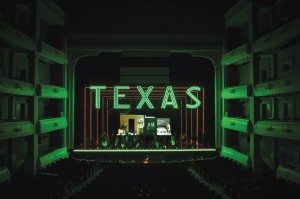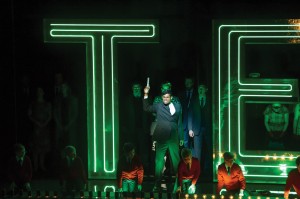
In early 2013, Woods attended an annual event organized by Opera America, a national nonprofit that supports opera and the musical arts. At New York City’s New Works Forum, a showcase of compositions by up-and-coming composers and librettists, Woods met Vavrek. The two musicians, who share a jovial disposition, quickly became friends. While chatting over drinks that week, Woods told Vavrek about the ambitious commission he was struggling with.
Vavrek listened intently. In the back of his mind, he had the perfect composer for the job, the young, rising David Little. Vavrek would have the opportunity to connect Woods and Little that fall when Woods returned to New York City to attend an opera workshop.
“Afterwards, [Vavrek] and I went to a bar, and I met David Little,” Woods recalled. “I didn’t really know him, but I had heard ‘Soldier Songs’ and some of the things he’d written. I was still thinking about Adamo or Heggie for the commission.”
Little told Woods that he was well versed in the intersection of art and politics. In 2011, Little wrote about the subject for The New York Times. Woods listened to recordings of several of Little’s compositions.
“His music had a rhythm that, to me, said Kennedy,” Woods recalled.
Woods and the FWO artistic staff decided to go with the duo.
The first step was to immerse the New Yorkers in Fort Worth culture. Little and Vavrek attended the Fort Worth Stock Show and Rodeo the next year and visited the Amon Carter Museum of American Art, the Sixth Floor Museum in downtown Dallas, and other historical sites.
And with that, Little and Vavrek returned home. The composer and librettist were tasked not only with fulfilling the FWO’s most ambitious and costly commission to date but with creating an opera that offered new insights into one of the darkest periods of this country’s history.
******

Three years into office in 1963, President Kennedy was eyeing a second presidential term with his running mate, Lyndon Johnson. In the previous election, despite the vice-president’s Texas roots, voters in the Lone Star State favored Kennedy by only three percentage points over his rival and the Republican nominee, Richard Nixon.
With the primary goal of shoring up those numbers, White House staff announced a November presidential visit to Texas in September 1963. On Thursday, Nov. 21, Kennedy, accompanied by his wife and Vice-President Johnson, among others, gave speeches in San Antonio and Houston before arriving in Fort Worth to spend the night at the Hotel Texas. The next morning, the president greeted a crowd of several hundred outside the hotel before famously telling them, “There are no faint hearts in Fort Worth.” Immediately afterward, he met reporters and private guests in the hotel for a breakfast event organized by the Fort Worth Chamber of Commerce.
As Little and Vavrek began their research, reading endless news clippings and watching documentaries, they ran into the same problem that had perplexed Woods two years earlier. There was a scarcity of events to draw on for the story. Initially, Vavrek gave the libretto a literal treatment, following events chronologically. Little was blunt in his opinion of those early drafts. There wasn’t enough material for him to breathe life into them musically, Little said. They needed to take a different direction, to broaden the scope of the work.
“Then [Little] and I watched a video of the breakfast speech on YouTube,” Vavrek recalled. “We began to see things that could have multiple meanings, like when the Texas Boys Choir sang, ‘The eyes of Texas are upon you.’ ”
The song, taken in the context of the day, Little said, seems perfectly normal.
“But from our [contemporary] perspective, it is downright spooky now,” he said.
The duo began uncovering tidbits of history that were suppressed at the time, like Kennedy’s frequent use of morphine to deal with chronic back pain and his oldest sister Rosemary’s botched lobotomy operation. Even before the assassination, Jacqueline had dealt with severe loss. Just months before the Fort Worth visit, the first lady gave birth to her third child, Patrick Bouvier Kennedy. The newborn succumbed to a lung ailment and died two days after birth. Jacqueline, the creative team realized, would still have been in the throngs of grief.
Working with the new insights, Vavrek started over from scratch. Now the Kennedys, long given royalty status in the American zeitgeist, would be brought down from the myth of Camelot and made human. Before the orchestration could begin, the new libretto would need to be approved by FWO staff, though.
The libretto draft first reached the FWO team on November 2014.
“During the first read-through, we were a little puzzled,” DePoint recalled.
Without the benefit of seeing how the libretto had evolved over the past year, FWO team members, who were no strangers to modern conceptual ideas about opera, were perplexed by the lengthy dream sequences and scenes on the moon. It took explanations from Vavrek and Little to quell their concerns. The FWO team largely endorsed the bold plotlines. But there were a few things that needed to be cut.
“Nudity,” DePoint said. “There was lots of nudity in the original libretto.”
While FWO artistic staffers aren’t prudes, the aim of the commission was to produce a work that would be welcomed by audiences around the world.
The project was then officially handed off to Little, who chose a 50-piece orchestra with a large percussion ensemble for the job. DePoint had made one other request. No amplified sound. While many contemporary composers, including Little, like to include electric guitars and synth samples in their soundscapes, the pending performance in Bass Performance Hall would need to hold on to some of grand opera’s traditions.
The results, Little said, were written to be honest to the story.
“I’m interested in color” as a composer, he said. “Percussion is a good way to keep color vibrant. It is kind of like painting. You do just enough green to make it just the right shade of blue.”
To achieve the ideal orchestral hues, Little delved deep into each instrumental line, he said. At certain moments, the violin section may be divided between three different bowing techniques to create three unique timbres, for example.
Recent rehearsals hint at what audiences can expect from opening night. The orchestral palette ranges from weighty choruses underlined by Mahleresque brass lines to hauntingly beautiful swirls of violin lines speckled with accompanying bells.
Once the libretto and music score were finished, set designer Strassberger began weighing various options for the final form of JFK’s stage. Vavrek had set each act in specific locations, Strassberger recalled, meaning separate spaces would need to be constructed. At one point, he pondered using a long row of rooms laid out lengthwise and parallel to the front of the stage, but he decided against it because the actors could move only to adjacent rooms. With a deadline looming, he opted on the current rotating platform concept, which was eventually built by the Canadian Opera Company after a bidding process.
The design of the Kennedys’ 1963 hotel room was a balance between historical accuracy and practical staging considerations, Strassberger said.
“You have to give the impression that you’re in that time period,” he said. “But if it’s super-documentary-looking it doesn’t work. The rooms don’t have a lot of details. I think Jack and Jackie wouldn’t have noticed a toilet brush, for instance. Everything on our stage has a purpose.”
Costume designer Mattie Ullrich had to take several things into consideration when designing Jacqueline’s iconic pink Chanel suit.
Jacqueline “had an amazing figure,” she said. “She was built almost like a popsicle stick and wore clothing really well. Our mezzo [Mack] is curvier. I had to [alter] the dress so it looked like the original suit and looked beautiful on [Mack]. I went for a darker version [of the original strawberry pink] color so with the stage lighting it would look like what we remember.”
Working with a living composer and librettist has made the process collaborative, with give and take coming from both sides of the creative team, Strassberger said.
“I think it’s a great first opera,” to open the festival with, he added. “The musical language is something that people who watch Breaking Bad would understand [with regard to how] images and sound are interwoven. Audiences shouldn’t feel there is any type of barrier to coming to the opera. I’ll be wearing jeans on opening night.”
******











